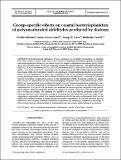Por favor, use este identificador para citar o enlazar a este item:
http://hdl.handle.net/10261/44710COMPARTIR / EXPORTAR:
 SHARE SHARE
 CORE
BASE CORE
BASE
|
|
| Visualizar otros formatos: MARC | Dublin Core | RDF | ORE | MODS | METS | DIDL | DATACITE | |

| Título: | Group-specific effects on coastal bacterioplankton of polyunsaturated aldehydes produced by diatoms |
Autor: | Balestra, Cecilia; Alonso-Sáez, Laura; Gasol, Josep M. CSIC ORCID ; Casotti, Raffaella | Palabras clave: | PUAs Bacterial composition Metabolism MAR-CARD-FISH Diatoms |
Fecha de publicación: | 2011 | Editor: | Inter Research | Citación: | Aquatic Microbial Ecology 63(2): 123-131 (2011) | Resumen: | Polyunsaturated aldehydes (PUAs), produced as secondary metabolites by diatoms, have been shown to induce toxic effects on a variety of organisms, including copepods and phyto- and bacterioplankton. However, the nature of and the players in this interaction remain poorly understood. We tested the effect of 3 PUAs commonly produced by marine diatoms—2E,4E/Z-heptadienal (HEPTA), 2E,4E/Z-octadienal (OCTA), 2E,4E/Z-decadienal (DECA) and a mix of HEPTA and OCTA (MIX)—on a natural bacterial community from a coastal area of the NW Mediterranean Sea (Blanes Bay, Spain). Little effect on total or relative cell abundance or bulk bacterial production was observed after 6 or 24 h exposure to 7.5 nM of the 3 different PUAs for the different bacterial phylogenetic groups (Gammaproteobacteria, Bacteroidetes, Rhodobacteraceae and SAR11), assessed by catalysed reporter deposition (CARD)-fluorescence in situ hybridisation (FISH). Metabolic activity, i.e. single-cell activity as determined by microautoradiography combined with CARD-FISH (MAR-CARD-FISH), was least affected by the addition of single PUAs in Gammaproteobacteria, markedly in Bacteroidetes and most markedly in Rhodobacteraceae, leading to a decrease in Rhodobacteraceae abundance by 21% (by 38% of the active cells assessed by leucine uptake) compared to the control. Bacteroidetes, although markedly affected in single-cell activity, were the most abundant group (54% of total cell counts). The addition of a mixture of OCTA and HEPTA produced a more pronounced decrease in the metabolic activity of all groups than the incubation with the single PUAs, suggesting a synergistic effect. Our results demonstrate that PUAs have a differential effect on the single-cell activity of distinct bacterial groups in natural communities. PUAs may therefore play an important role in shaping bacterial community composition by conferring a competitive advantage to PUA-resistant groups, allowing them to preferentially use the organic matter released by diatoms | Descripción: | 9 pages, 4 figures, 2 tables | Versión del editor: | https://doi.org/10.3354/ame01486 | URI: | http://hdl.handle.net/10261/44710 | DOI: | 10.3354/ame01486 | ISSN: | 0948-3055 | E-ISSN: | 1616-1564 |
| Aparece en las colecciones: | (ICM) Artículos |
Ficheros en este ítem:
| Fichero | Descripción | Tamaño | Formato | |
|---|---|---|---|---|
| Balestra_et_al_2011.pdf | 419,45 kB | Adobe PDF |  Visualizar/Abrir |
CORE Recommender
SCOPUSTM
Citations
44
checked on 13-abr-2024
WEB OF SCIENCETM
Citations
44
checked on 24-feb-2024
Page view(s)
314
checked on 18-abr-2024
Download(s)
189
checked on 18-abr-2024
Google ScholarTM
Check
Altmetric
Altmetric
NOTA: Los ítems de Digital.CSIC están protegidos por copyright, con todos los derechos reservados, a menos que se indique lo contrario.
